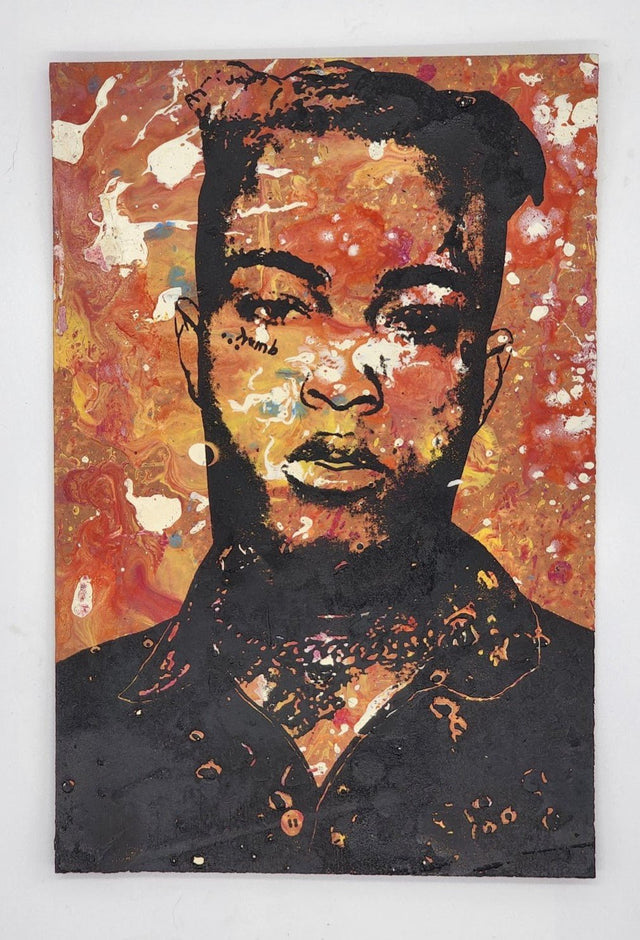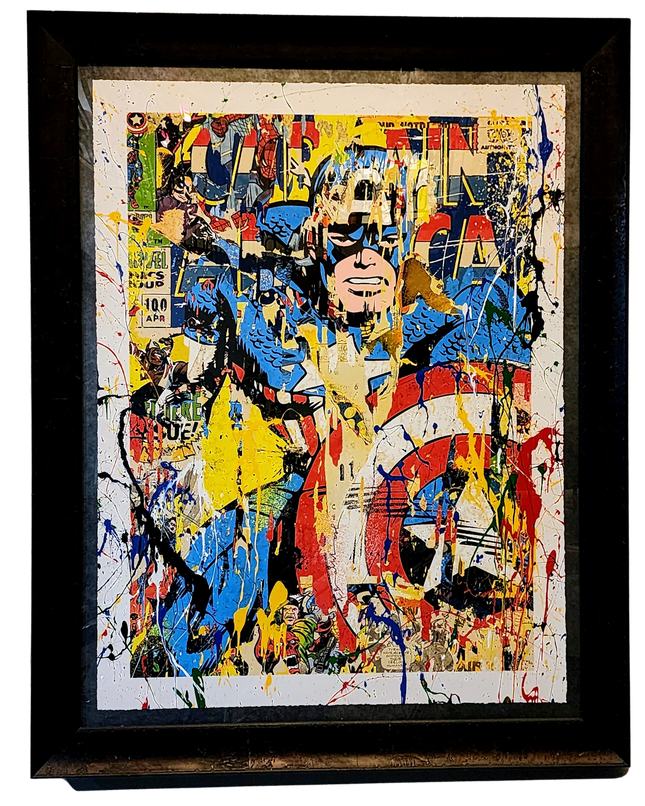
Man Male

Mr Brainwash- Thierry Guetta Captain America HPM Spray Paint Silkscreen Print by Mr Brainwash- Thierry Guetta
Captain America HPM Spray Paint Silkscreen Print by Mr. Brainwash- Thierry Guetta Mixed Media Screen Print on Deckled Fine Art Paper Limited Edition Pop Street Art Artwork. 2018 Signed Custom Framed Spray Paint, Acrylic Paint Mixed Media HPM Embellished Artwork Size 36.5x48.5. Stylistic Comic Book Cover of Marvel Comics Superhero Captain America with Tons of Colorful Spray Paint & Paint Hand-Embellished. Custom Ornate Antiqued hammered Style Bronze Colored Frame Size 46.5x58.5 Thierry Guetta's Artistic Interpretation of Captain America In Street Pop Art and Graffiti Artwork, 2018 witnessed an extraordinary fusion of comic book heroism and urban visual language with Thierry Guetta, known in the art world as Mr. Brainwash, presenting his unique creation, "Captain America." This piece exemplifies the daring blend of classic superhero imagery with the raw, expressive power of street art techniques. Thierry Guetta's work frequently disrupts the conventional boundaries between high art and popular culture, drawing upon familiar symbols from our collective consciousness and reimagining them through a lens of gritty realism and vibrant abstraction. In "Captain America," Guetta showcases his distinctive style of high-energy, mixed-media artistry, which has become a hallmark of his oeuvre. This stunning, hand-embellished silkscreen print brings the iconic Marvel Comics superhero to life on a deckled fine art paper background. The dynamic use of spray and acrylic paints further accentuates the artwork, which drapes the superhero in a cascade of vivid, dripping color. This is not just a representation of Captain America; it is an embodiment of the character's essence, rendered through the prism of street art sensibility. Composition and Craftsmanship in "Captain America" Guetta's "Captain America" represents the artist's skill in manipulating form and content to deliver a powerful visual statement. The composition borrows the layout of a stylistic comic book cover, yet it is fractured and reassembled with a controlled chaos characteristic of Guetta's work. The artwork is a limited edition piece carrying the artist's signature, which attests to its authenticity and the prestige of owning a Guetta original. The size of the artwork, measuring 36.5x48.5 inches, provides a grand canvas for Guetta's explosive creativity. In contrast, the custom ornate antiqued hammered-style bronze-colored frame, sizing 46.5x58.5 inches, gives it a sturdy and majestic enclosure. The impact of Street Pop Art, as seen in Guetta's "Captain America," is profound, signaling a shift in how contemporary society consumes and appreciates art. Through the lens of this genre, icons like Captain America are not merely subjects to be depicted; they are canvases onto which the complexities of our time are projected. Guetta's work, with its thick layers of paint and dramatic splatters, challenges the viewer to see beyond the surface to engage with the symbols of our culture in a way that is both critical and celebratory. Collecting and Valuing Guetta's Street Pop and Graffiti Artwork As a cultural artifact, "Captain America" carries significant weight. The superhero is an emblem of justice, freedom, and the American spirit, ideals consistently resonating with audiences worldwide. Guetta's interpretation does not shy away from these connotations but embraces and amplifies them. By applying the anarchic motifs of street art to this symbolic figure, Guetta invites discourse on the role of such heroes in today's society. The result is an artwork that is as thought-provoking as visually arresting. Collectors and fans of art and comic book lore are drawn to pieces like Guetta's "Captain America" for their aesthetic appeal, investment potential, and cultural resonance. The convergence of street art's accessibility and pop art's mass appeal has created a fertile ground for artists like Guetta to flourish. His works, particularly those that engage with iconic figures, become not just art to be hung on a wall but conversations to be had, questions to be asked, and histories to be written. Thierry Guetta's "Captain America" vividly illustrates the power of street pop art and graffiti artwork to communicate, revolutionize, andmemorialize. It is a piece that captures the zeitgeist, a piece that is as much about the storied past of a beloved superhero as it is about the ongoing narrative of street art's place in the annals of art history. As Guetta's work continues to intrigue and inspire, it is a poignant reminder of the evolving dialogue between art and society. This conversation is rendered in bright colors, bold strokes, and the indelible ink of a silkscreen print.
$22,500.00


